Over 50% of all internet searches are voice-activated and that number will continue to increase as more people purchase smart speakers and start using voice features on their mobile devices.
With over 1 billion voice searches being done each month, it’s time to optimize your voice search SEO to make sure you’re reaching new customers.
Now is a great time for you to learn all about it. Just take a look at these voice search statistics to see why it should be part of your search engine optimization strategy:
- The number of U.S. households expected to own a smart speaker in 2022 is 55%
- About 20% of mobile searches are done using voice
- More than half of people (58%) use voice search to learn about local businesses
- 72% of people using voice search have made it part of their daily routines
You’re probably wondering why voice search is growing so quickly? For one, it’s much easier and quicker than typing in your search.
And it’s easier to use when you’re on the go looking for a specific retailer or restaurant to have lunch.
Voice-activated devices are also becoming more affordable and easy to get. Who knows if we’ll even be using keyboards in the future?
Are you reading to learn more about how to adapt to the voice search revolution? Keep reading to learn how this can be part of your winning strategy.
The Major Players: Google vs. Siri vs. Alexa
When you do a voice search on mobile devices, computers, or smart devices, it runs through a voice assistant.
But, it turns out not all voice assistants are created equal when it comes to optimizing voice search SEO.
The most popular voice assistants include Alexa, Siri, and Google Assistant.
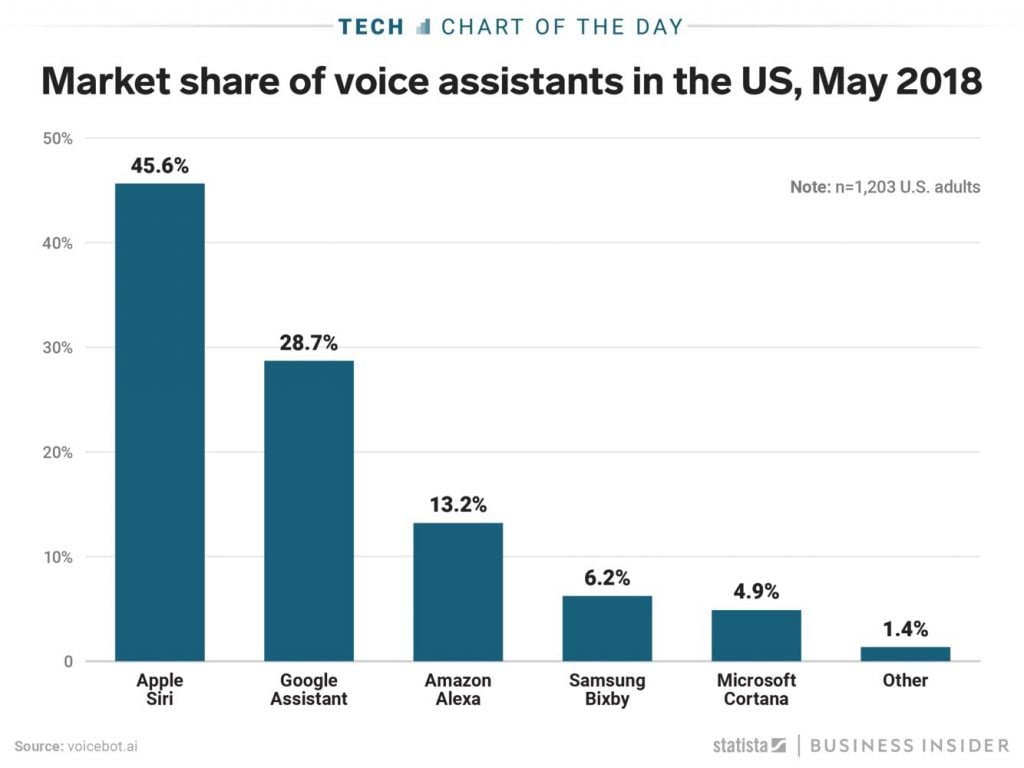
Google Assistant and Siri both pull from Google when someone makes a query, yet Apple’s Siri will also search for information on other search engines like Yahoo, Bing, or from Apple third-party apps.
Siri has the largest market share thanks to iPhones, iPads, and Apple Watches.
Alexa, which is an Amazon product, is programmed to draw its information from Bing.
What this means is you’ll have to think about what search engine your audience uses. For example, it wouldn’t make sense to optimize your voice search SEO only on Google when a large share of your target audience uses Alexa.
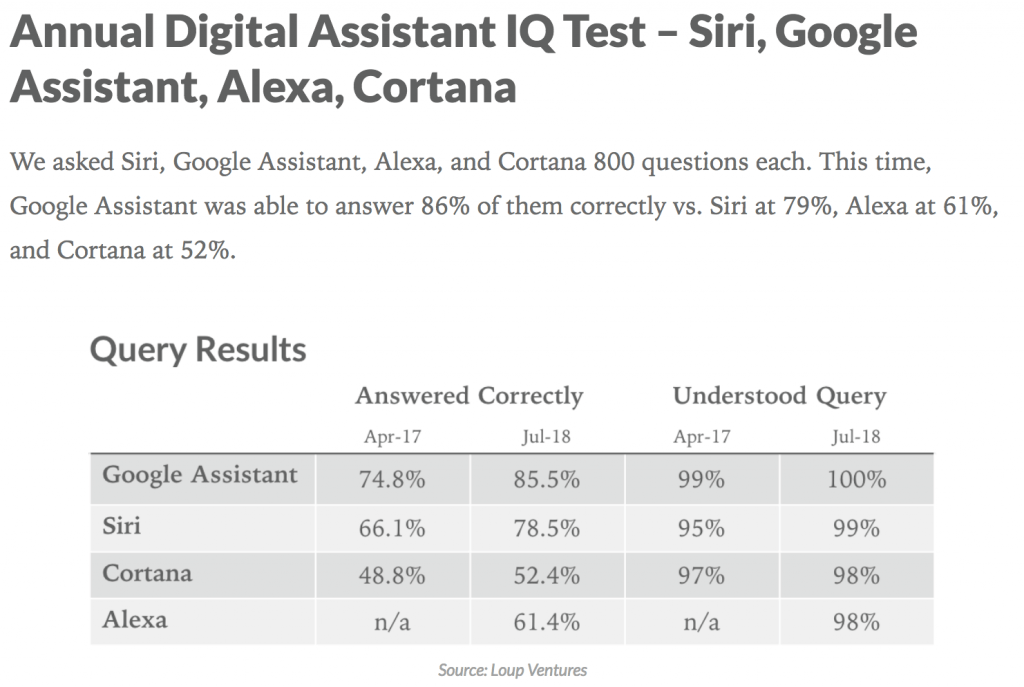
SEO experts recommend doing optimization for all three of these platforms for the best results.
Differences Between Voice Search vs. Typed Search
Every Google search runs the same way. It’s an algorithm after all.
But, user behavior is the main difference between voice search and type search. How we conduct a search changes based on where we are and what we’re looking for.
Keep reading to learn more.
How We Search
The way we speak to voice assistants creates new voice search keywords that are more conversational than typed keywords.
You might normally type “pumpkin pie recipe,” but with a voice query you’d be more likely to say, “How do I make pumpkin pie?”
There’s a different featured recipe result for each query:
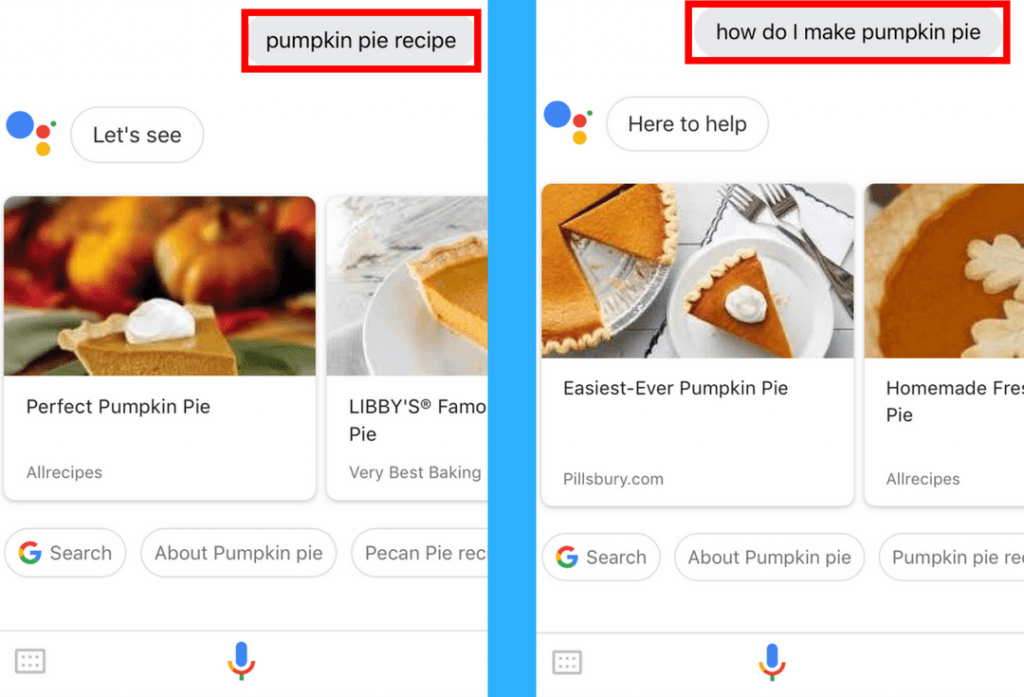
The way this works is related to Google’s Hummingbird update.
With Hummingbird, Google became an “answer engine.” Now you can get tons of relevant SERP results right on Google without clicking on a website.
Hummingbird emphasized semantic search (conversational keywords) and implied query meaning (the intent behind the search terms).
What does this mean for your voice search optimization? You’ll need to focus on conversational keywords related to a user’s voice recognition versus simple terms they may enter into a browser.
Google’s RankBrain can pick up what searchers are looking for. RankBrain is part of the core algorithm and uses machine learning to deliver relevant results.
Google’s Knowledge Graph shows them that result in an infobox:
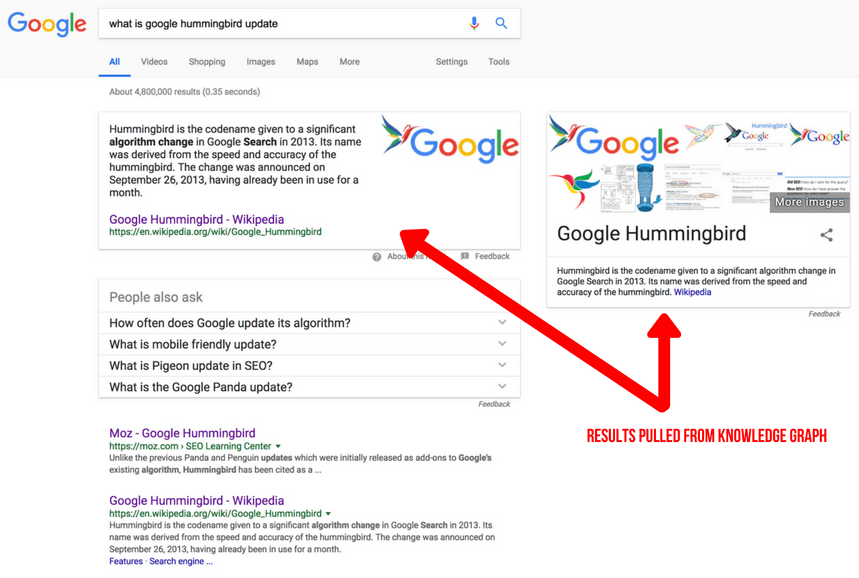
Google divides intent into 4 main categories: informational, navigational, actional, and transactional. Or: “I want to [know, go, do, or buy]”.
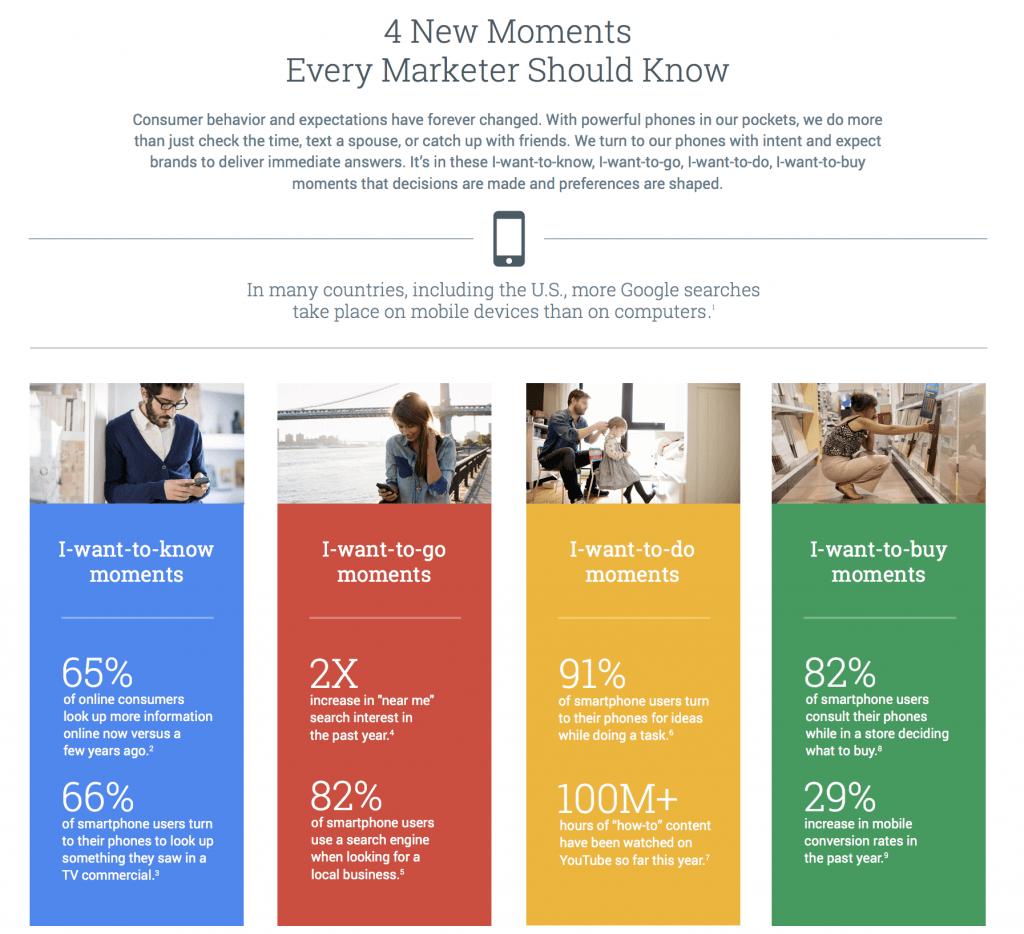
To demonstrate how this all works, you might
search for: “Who is Ric Flair”
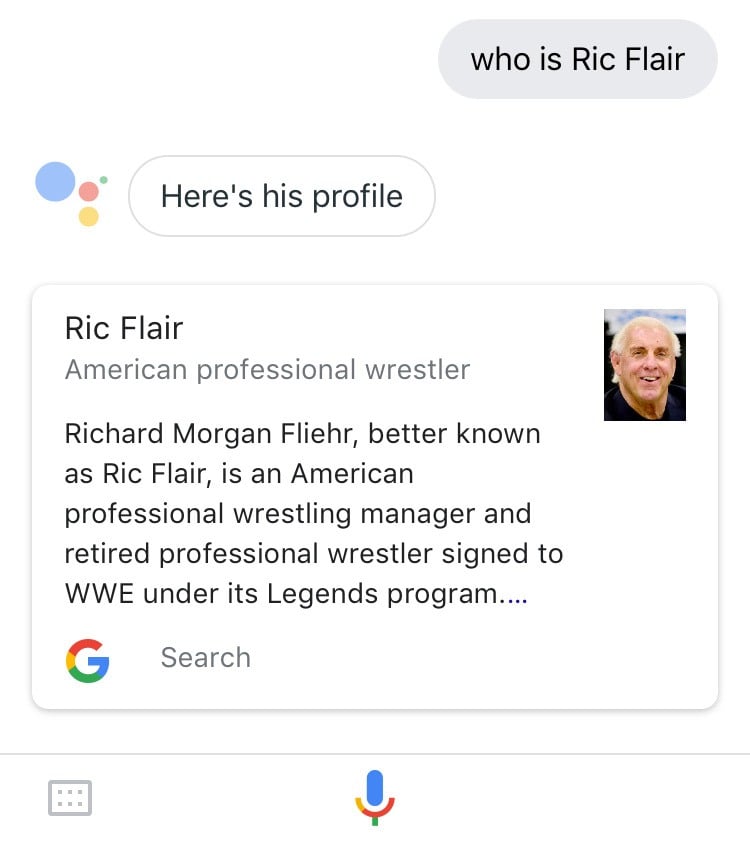
Now if I ask a follow-up question, “Where is [he] from?” Google will understand the implied meaning of “he” as Ric Flair:
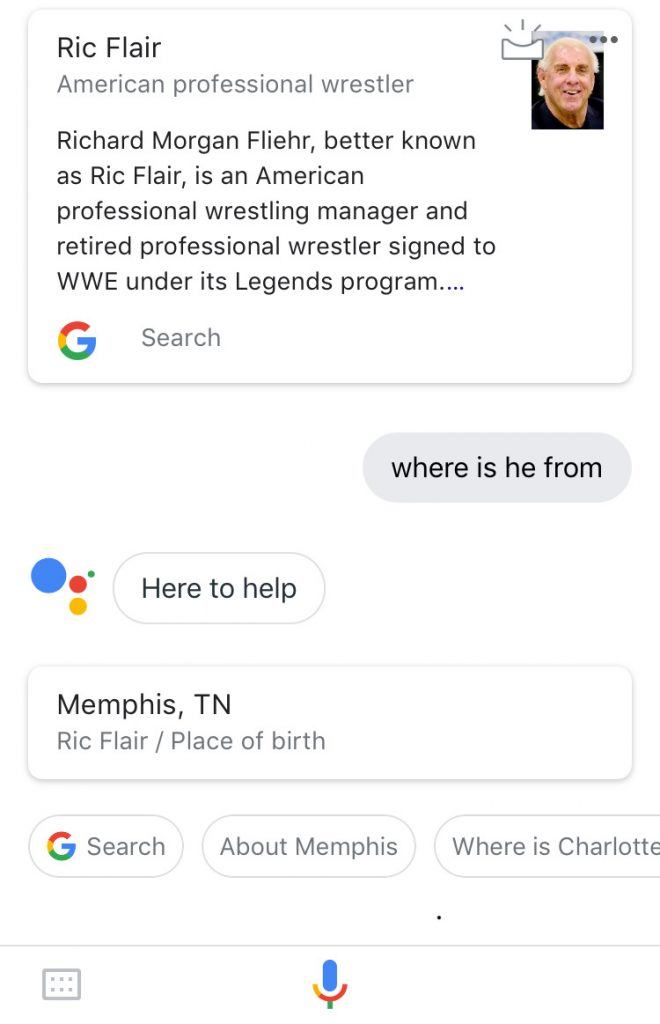
Because of my first search, Google knows who I’m talking about. Each question is relevant to the one before it, rather than each search being treated as a blank slate.
This is a more conversational and intuitive experience. And it’s why semantic search is central to voice search.
Because of my first search, Google knows who I’m talking about. Each question is relevant to the one before it, rather than each search being treated as a blank slate.
This is a more conversational and intuitive experience. And it’s why semantic search is central to voice search.
When We Search
People use voice search all the time: at home, in the office, and on the go.
This is mainly taking place on mobile devices, which makes sense as people are most likely to use voice search on their mobile devices while driving.
The on-the-go usage of voice search is reflected by how “near me now” searches have grown.
Google uses its geolocation data to provide an answer to a “near me” search:
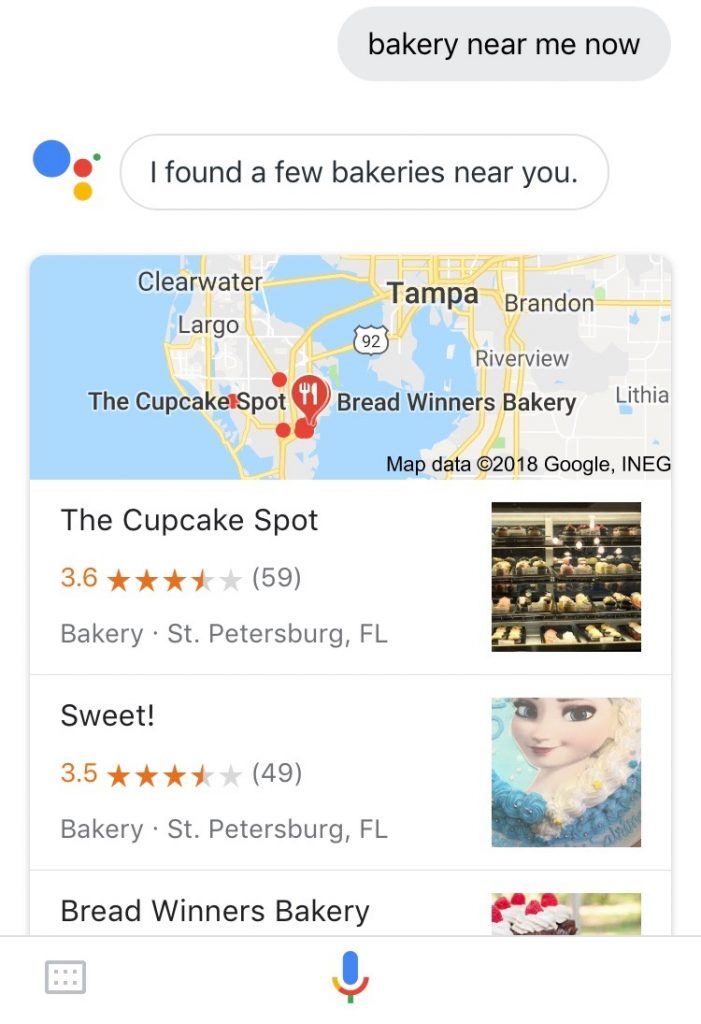
The same search with Siri will yield different results from Apple’s Maps app, which uses data from multiple companies including Yelp and Foursquare:
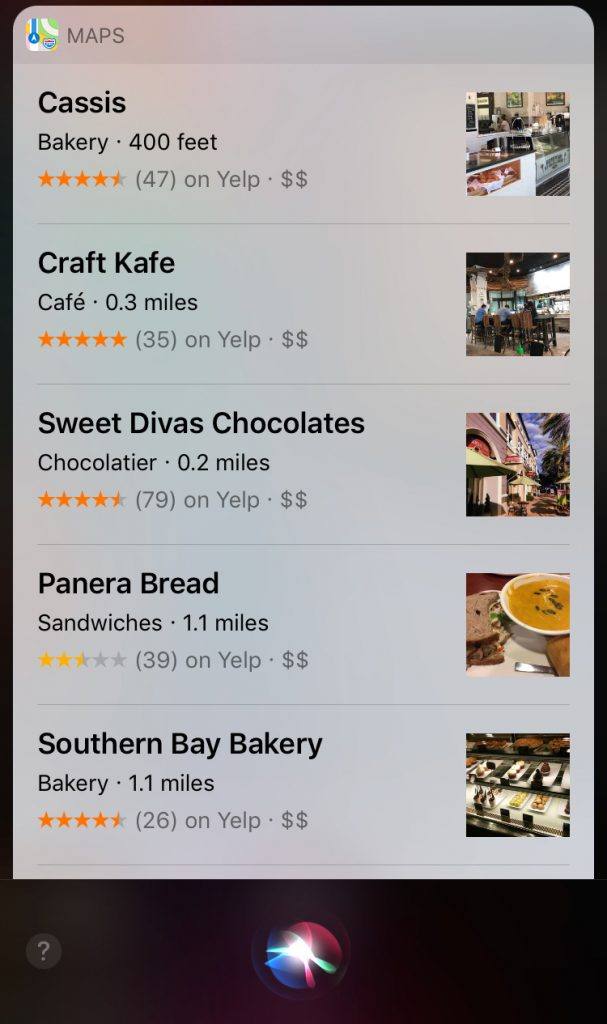
While Siri and Google use different geographic databases, when it comes to regular search results they both use the Google algorithm.
Google will usually read concise answers to you if it’s found in a featured snippet:
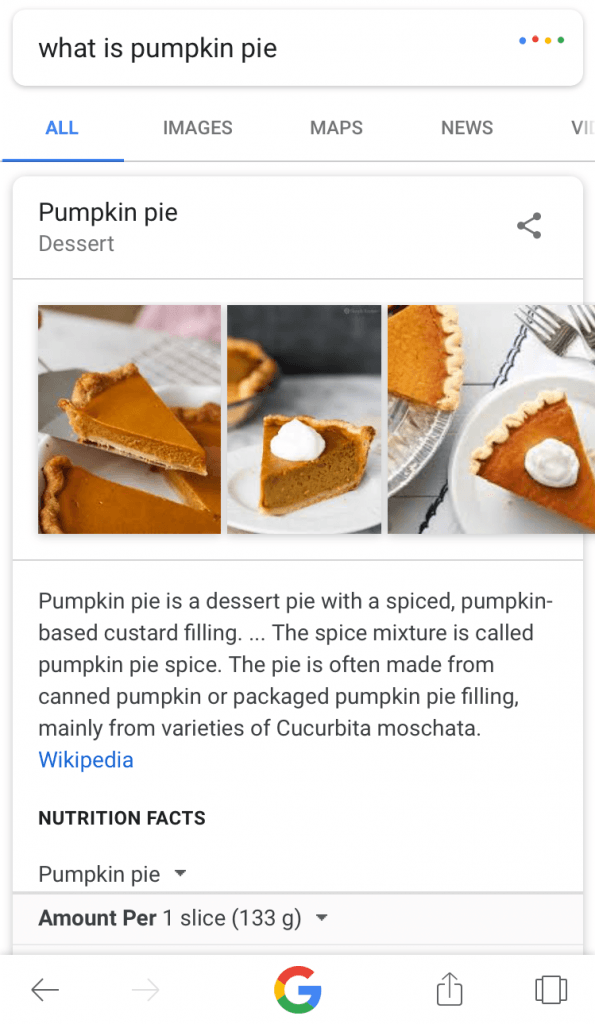
The same search with Siri will yield different results from Apple’s Maps app, which uses data from multiple companies including Yelp and Foursquare:
While Siri and Google use different geographic databases, when it comes to regular search results they both use Google.
Google will usually read the answer to you if it’s found in a featured snippet:
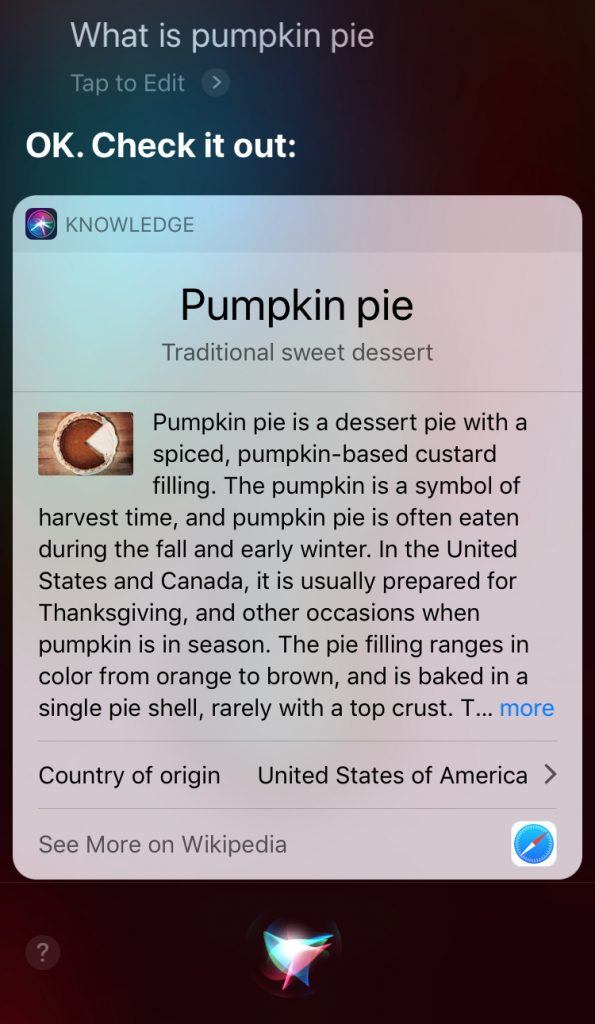
What We Search For
Think about what information you seek when using voice search. Most people are using it while driving or do not want to stop what they’re doing to type out a search.
They’ll ask questions like “where’s the closest coffee shop” or “show me size 8 shoes” in voice search.
No one is looking for web pages with a ton of text. They want a featured snippet, a link to product pages, or a redirect to Google Maps for directions.
Google knows you’d rather get a quick direct answer in the results. That’s why they’re so focused on featuring that micro-data in search results.

-
Don’t have time to read the entire guide right now?
Let us send you the downloadable version so you can read it when it’s more convenient for you.
Or if you were researching dog breeds. In a traditional search, you may type “common dog breeds” and navigate through multiple pages to find what you need.
The voice search could get you exactly what you need if you asked “what are the most common dog breeds?”
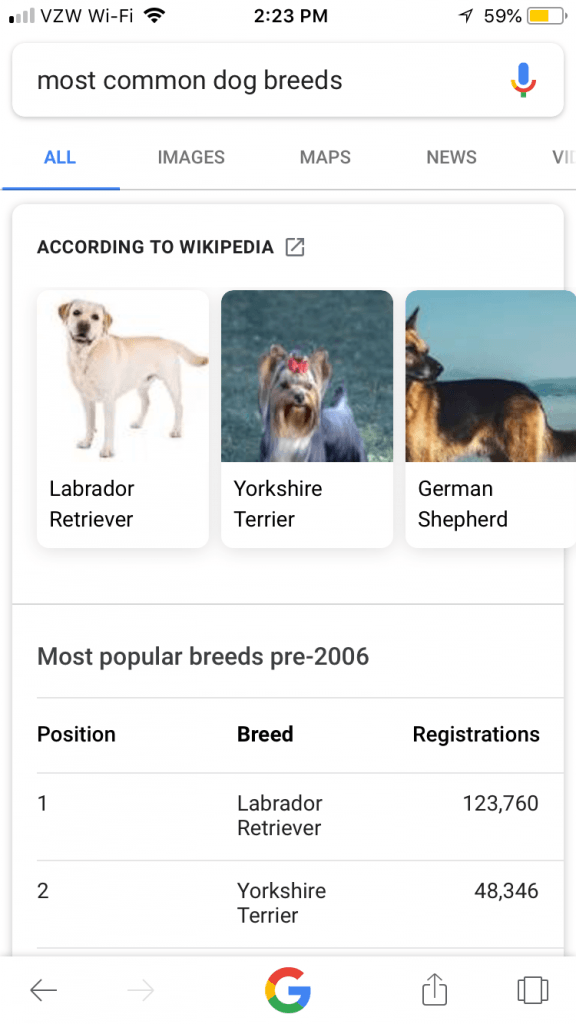
You’ll still get regular search results when you do a voice search, but if Google reads you the featured result and it satisfies your query, you won’t bother with the lower results.
#1: How to Find Voice Search Keywords
The normal keyword length is getting longer, and voice search keywords are naturally long due to the way we speak.
When looking for voice search keywords, think of phrases or questions you may say to a friend during a conversation. Or better yet, think about how you would make the voice search if you were on the go.
Natural language keywords, the kind you use for voice search SEO, are going to be 5 words or longer.
For example, if you’re in the middle of baking a cake you may use a voice search to find out “how many tablespoons are in a cup?” That’s an example of a natural language keyword.
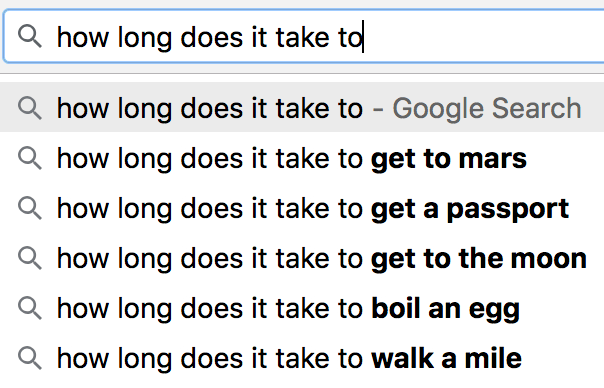
Here’s where it gets really interesting. How you phrase the question could change your results.
For example, I might type “how to do link building,” while a voice search could be “How do I build more links to my website?”
Need help getting started? You can use one of these keyword research tools:
You can use third-party tools like AnswerThePublic.com or Ubersuggest to mine for question keywords that people are saying.
Here’s an example of how AnswerThePublic displays questions after you enter a keyword (“online marketing” in this case):

You can also sort AnswerThePublic’s questions into a “Data” view to make them easier to read like a list:
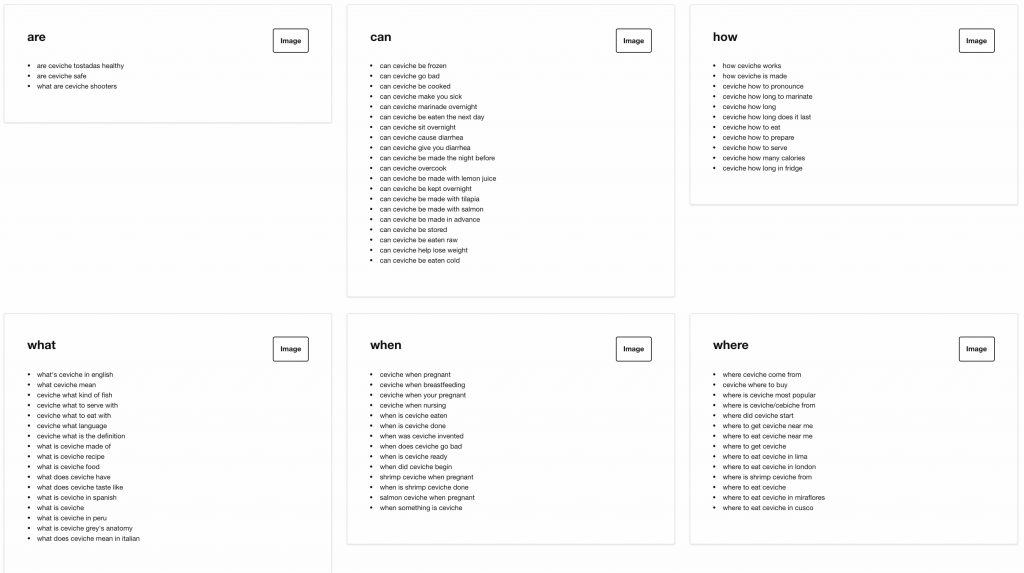
In Ubersuggest, you can filter the list of suggested keywords by ones that contain “question words” like what, how, when, etc.:
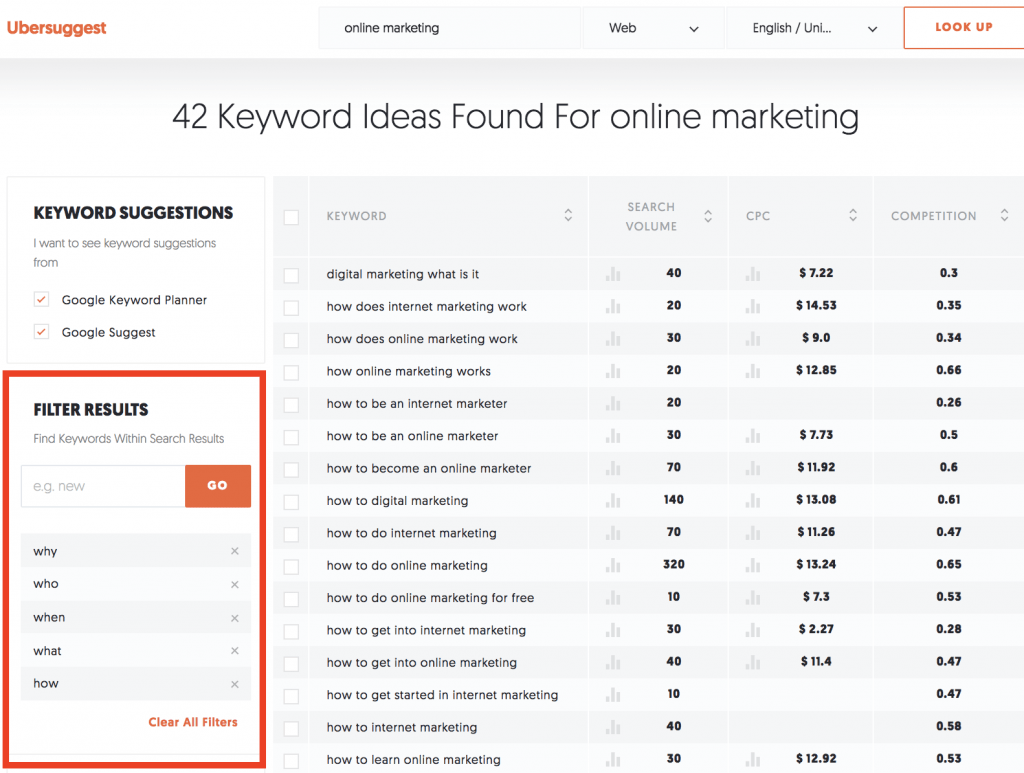
For another approach, I recommend you try mining live chat or email data to find the commonly asked questions surrounding your company, product, or service.
What do you do with these crazy long keywords? Optimize your on-page SEO by sprinkling them in your content.
Let’s get into how to include them.
#2: How to Optimize Content for Voice Search
Once you’ve found your voice search keywords, you can start optimizing your content around them.
1. Picking a Topic
Build content that answers commonly asked questions about your brand, services, products, etc…
This includes content that answers “who, what, when, where, why, and how” questions.
Your focus for voice optimization centers around embedding those keywords into your content. Don’t try to optimize your page itself to the voice terms, because less than 2% of voice results had exact KW in their title tag.
Optimize your pages as you normally would, and include as many queries that sound like voice terms on them.
2. Structuring Answers
Embed long tail keywords into your content as answers to the questions being asked.
A general guideline for the answers you provide is to keep them at 30 words or less.
Brian Dean did a study of voice search queries and found that Google tends to answer voice searches in short, 29-word results on average.
Shorter/Longer answers are provided by Google as well though. For example, the current answer to:
- “What is the longest season?” is 30 words
- “Do bee stings hurt?” is 50 words
- “How long do cats live?” is 6 words
So statistically, you can increase the odds of your answer being used by keeping it at around 30 words.
However, it’s worth testing your questions in Google to see what length a competing result’s answer is and aiming for that length yourself.
3. Optimize Long-Form Content For Voice Search SEO
When creating long-form content, embed as many answers as you can into it. Not only will you be helping clients to learn about your brand but those answers may get picked up by a voice search.
Do this by inserting long-tail keywords that are longer and more specific to a topic.
One example of a long tail keyword is “matching wedding and bridesmaid dresses.”
This type of keyword is more competitive than one like “bridesmaid dresses” but it’s more likely to deliver a conversion because the searcher is looking for something specific.
These long-tail keywords can be added as answers embedded in the text of your content or as H2 and H3 headings.
So, for example, one of the headings in a 2,000-word blog post could be “Tips For Matching Wedding and Bridesmaid Dresses.”
You can also structure your long-tail keywords as questions such as “where’s the closest coffee shop?” These searches are more popular thanks to voice apps and Google wants to give users answers of around 30 words or less.
Long-form content is also more likely to increase your overall rankings because there are more opportunities for keywords to get picked up by a Google search.
It’s playing the numbers game!
According to Brian Dean’s study, 40.7% of voice search results came from a featured snippet.
That means by also optimizing for featured snippets, you can improve the odds of your content landing in voice searches.
So how do you optimize for featured snippets? Leverage structured data by using schema markup depending on the content type.
For example, if you’re answering “how to change a flat tire” you would use “HowToSection” markup in your page’s code to help Google crawl through the content and recognize the data.
In addition to using schema markup, ensure content is structured well by using headers and bulleted or numbered lists.
Of course, not all of your content should be long.
One way to create short content targeted for voice search keywords is by creating a FAQ page (frequently asked questions). Long-tail keywords can be used in your FAQ for a quick answer.
Here’s an example in an article we wrote about domain authority.
#2: How to Optimize Content for Voice Search
Once you’ve found your voice search keywords, you can start optimizing your content around them.
The other advantage is that by optimizing for voice search, you’re structuring your content a lot better in terms of what Google likes to see.
Here’s how to do it:
1.Picking a Topic
Build content that answers commonly asked questions around your brand, services, products, etc..
This includes content that answers “who, what, when, where, why and how” questions. Picking topics this way makes it easy to include all of those voice keywords you found.
Your focus for voice optimization centers around embedding those keywords into your content. Don’t try to optimize your page itself to the voice terms, because less than 2% of voice results had exact KW in their title tag.
Optimize your pages as you normally would, and include as many queries that sound like voice terms on them.
2. Structuring Answers
Embed long tail keywords into your content as answers to the questions being asked.
A general guideline for the answers you provide is to keep them at 30 words at less.
Brian Dean did a study of voice search queries and found that Google tends to answer voice search in short, 29-word results on average.
Shorter/Longer answers are provided by Google as well though. For example, the current answer to:
- “What is the longest season?” is 30 words
- “Do bee stings hurt?” is 50 words
- “How long do cats live?” Is 6 words
So statistically, you can increase the odds of your answer being used by keeping it at around 30 words.
However, it’s worth testing your questions in Google to see what length a competing result’s answer is and aiming for that length yourself.
3. Optimize Long-Form Content For Voice Search SEO
When creating long-form content, embed as many answers as you can into it. Not only will you be helping clients to learn about your brand but those answers may get picked up by a voice search.
Do this by inserting long-tail keywords that are longer and more specific to a topic.
One example of a long tail keyword is “matching wedding and bridesmaid dresses.”
This type of keyword is more competitive than one like “bridesmaid dresses” but it’s more likely to deliver a conversion because the searcher is looking for something specific.
These long-tail keywords can be added as answers embedded in the text of your content or as H2 and H3 headings.
So, for example, one of the headings in a 2,000-word blog post could be “Tips For Matching Wedding and Bridesmaid Dresses.”
You can also structure your long-tail keywords as questions such as “where’s the closest coffee shop?” These searches are more popular thanks to voice apps and Google wants to give users answers of around 30 words or less.
Long-form content is also more likely to increase your overall rankings because there are more opportunities for keywords to get picked up by a Google search.
It’s playing the numbers game!
According to Brian Dean’s study, 40.7% of voice search results came from a featured snippet.
That means by also optimizing for featured snippets, you can improve the odds of your content landing in voice searches.
So how do you optimize for featured snippets? Leverage structured data by using schema markup depending on the content type.
For example, if you’re answering “how to change a flat tire” you would use “HowToSection” markup in your page’s code to help Google crawl through the content and recognize the data.
In addition to using schema markup, ensure content is structured well by using headers and bulleted or numbered lists.
Of course, not all of your content should be long.
One way to create short content targeted for voice search keywords is by creating a FAQ page (frequently asked questions). Long-tail keywords can be used in your FAQ for a quick answer.
Here’s an example in an article we wrote about domain authority.
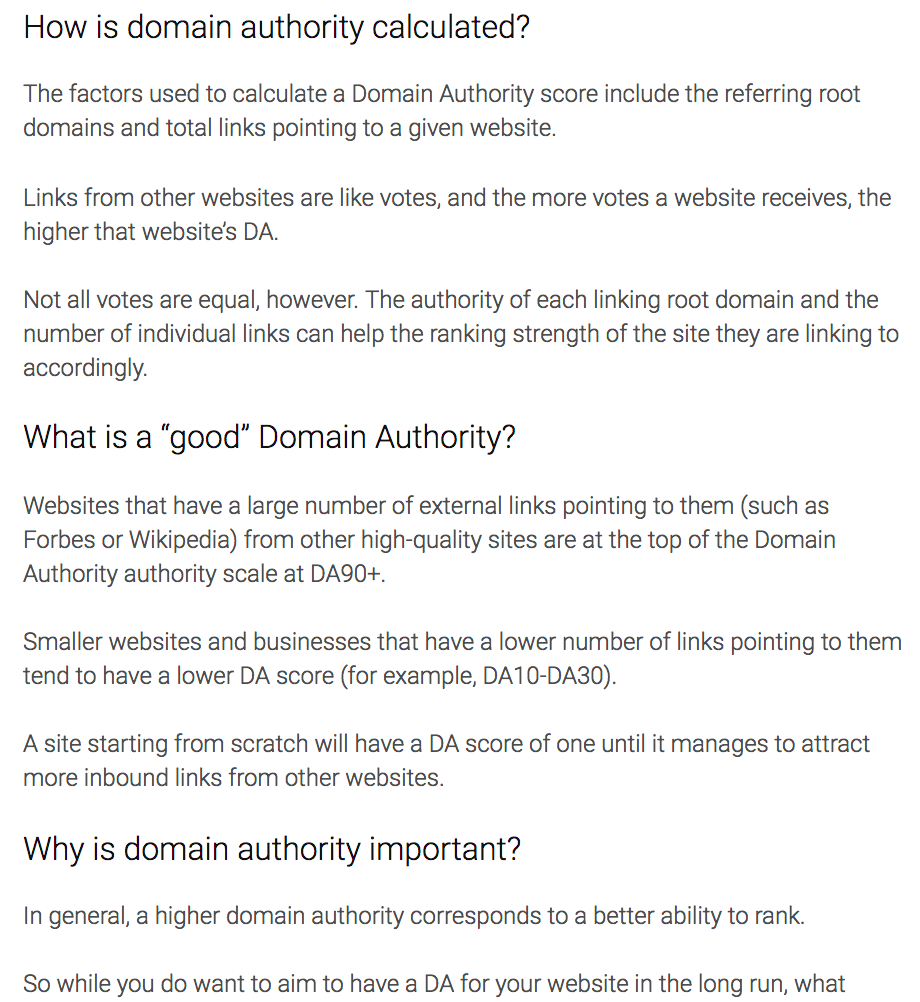
#3 Voice Search Tips for Local SEO
The possibilities for capturing local customers with voice search optimization are exciting.
Look at how the information provided on The HOTH’s website and our Google Business Profile appears for different queries.
“What is the HOTH” brings up a miniature version of our Google Business Profile in Google’s Assistant app:
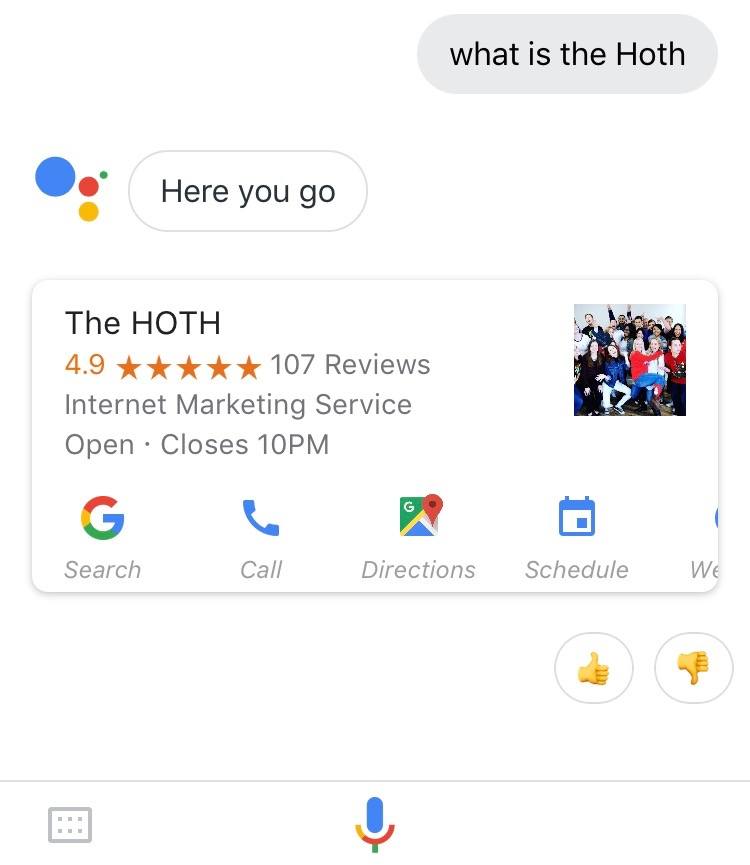
“Directions to The HOTH” uses my location to provide the route:
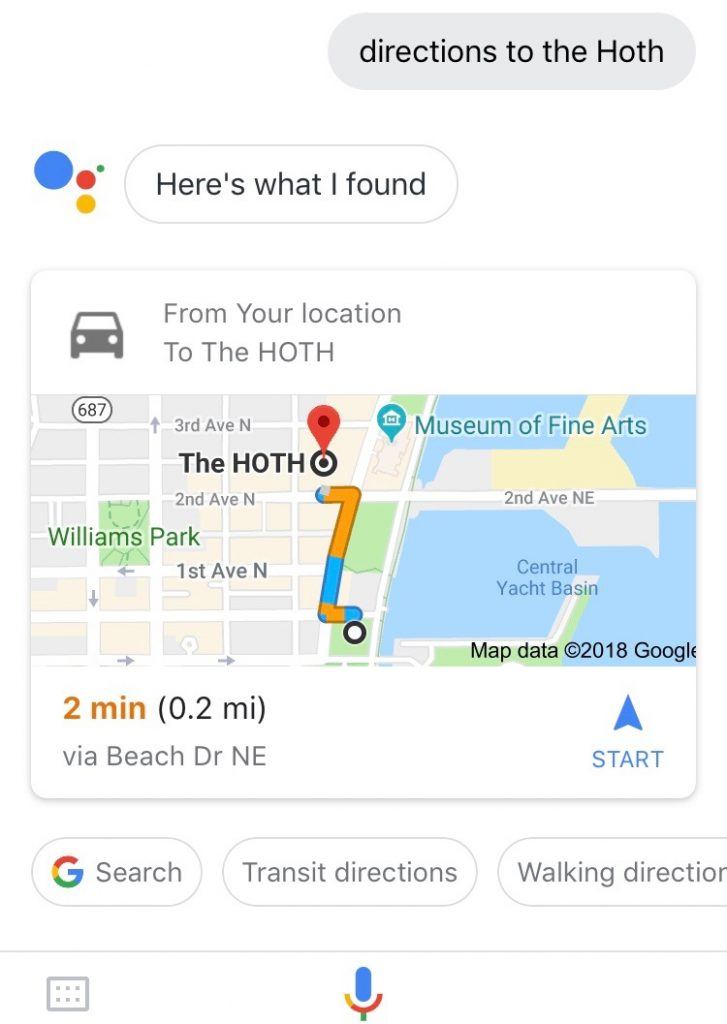
“What does the HOTH sell” crawled one of our articles to provide the answer:
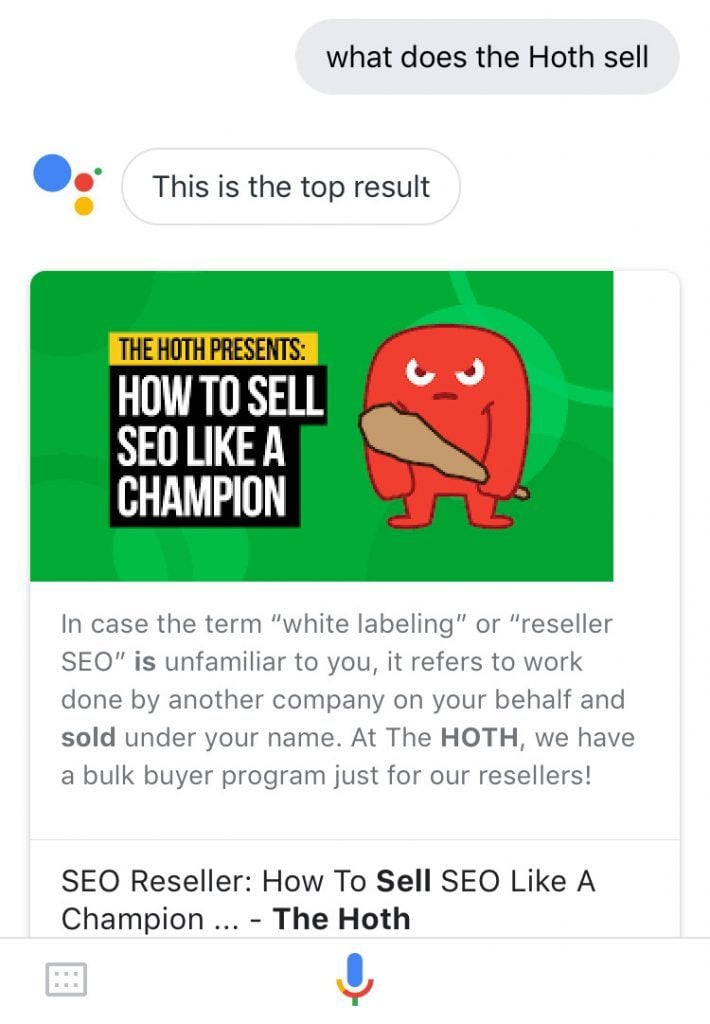
There are a couple more things to keep in mind for local search and voice:
Voice search users tend to search for a local business by saying either:
- “Hair salon in Tampa” — In this case, Google relies upon on-site content to generate results
- “Hair salon near me” — With “___ near me” searches, Google shows the nearest relevant Google Business Profile listings in the results
This is why it’s important to not only optimize your website’s content to these queries but to also claim and optimize your Google Business Profile.
Your GBP listing also helps to ensure that the correct name, address, and phone number (NAP) for your business is accurate when it shows up as a result.
Additionally, it’s important to use GBP’s feature of choosing the category of what your business is.
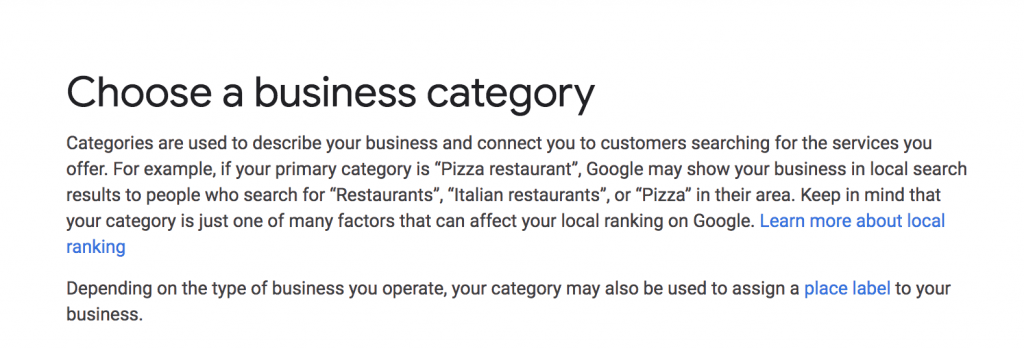
#4: Other SEO Factors Affecting Your Voice Search SEO
There are a few other things to keep in mind that can improve the number of times you appear as a result.
1. Work to get your brand in the Knowledge Graph
The more data Google has about you, your site, and your target audience, the better your chances will be to appear on the Knowledge Graph panel.
Using structured markup in your content helps with this, as mentioned above.
You can also fill out social media profiles and associate them with your brand to provide even stronger signals to Google.
If you can, get a Wikipedia page. Wikipedia results often appear for voice queries seeking general knowledge.
2. Aim for a 9th-grade reading level (or below)
Clear writing is a good guideline in general.
Content written at a 9th-grade reading level or below tends to appear more often as a voice result.
The Flesch-Kincaid Grade Level tells you what grade your content is at. For example, a score of 9.2 would be a 9th-grade reading level.
You can test the reading level of your content by using a tool like readable.io that lets you paste text in to see its grade score.
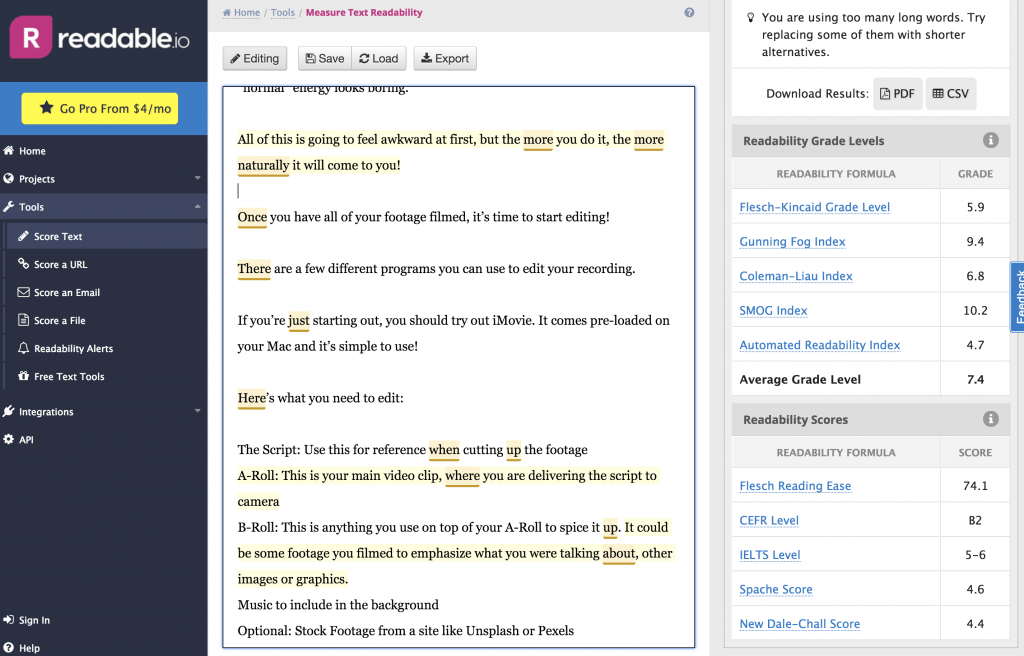
3. Increase Domain Authority
Sites with lots of links pointing to them tend to rank more often in regular searches.
You would expect it to be the same for voice, and it is. Brian Dean’s study (and our tests) found that sites with lots of links indeed rank more often in voice search.
The average Ahrefs Domain Rating of a voice result in Brian’s study of 10,000 Google Home search results was nearly 77.
Page Authority, on the other hand, is not as important for voice search as Domain Authority.
Domain Rating (DR) and URL Rating (UR) are Ahrefs’ equivalent of Moz’s Domain Authority and Page Authority.
Here’s an example of a featured snippet from a page with a low UR (13), but on a site with a good DR (63):

The good DR of this site is what landed this page in the snippet:

Google wants to provide results from authority sites. Build up your domain authority so that Google uses your site.
4. Rank videos in search results
Video seems to be a big part of Google’s strategy for answering voice queries. They tend to show up more for natural language keywords.
To show you what I mean: when I do a standard search for “pineapple cut,” Google knows that I want to know how to cut a pineapple.
They put the videos as the 3rd featured result after the text snippet and the related questions people also ask:
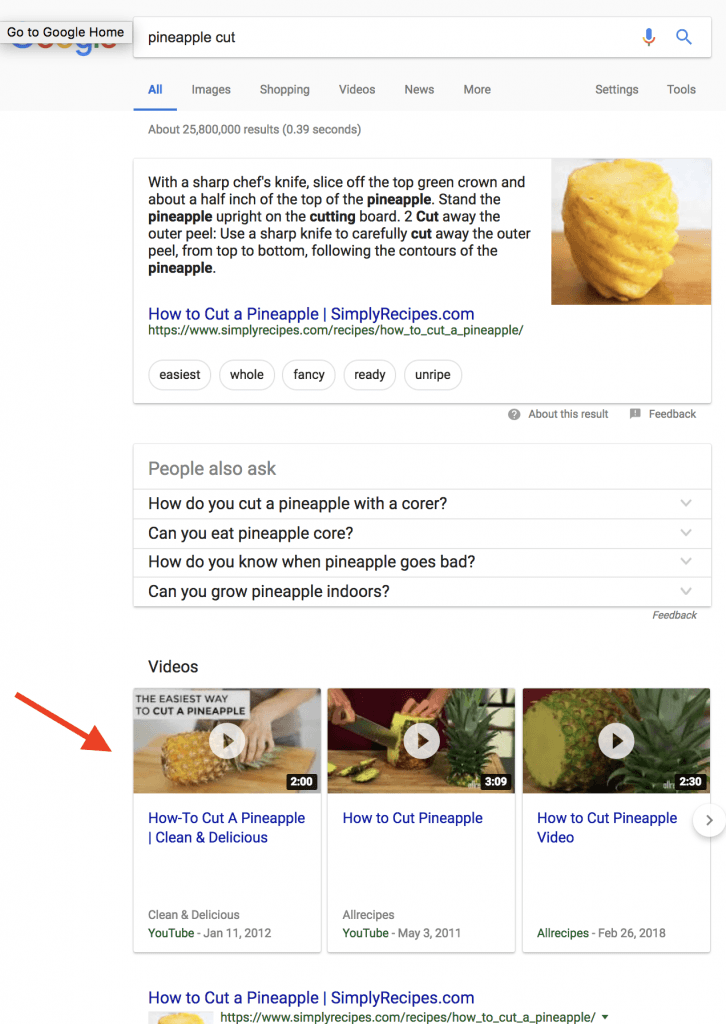
When I use a natural language keyword (“how do I cut a pineapple”) I get the video snippet at the top. Snippets like this one even automatically start at the relevant part of the video that answers my specific query:
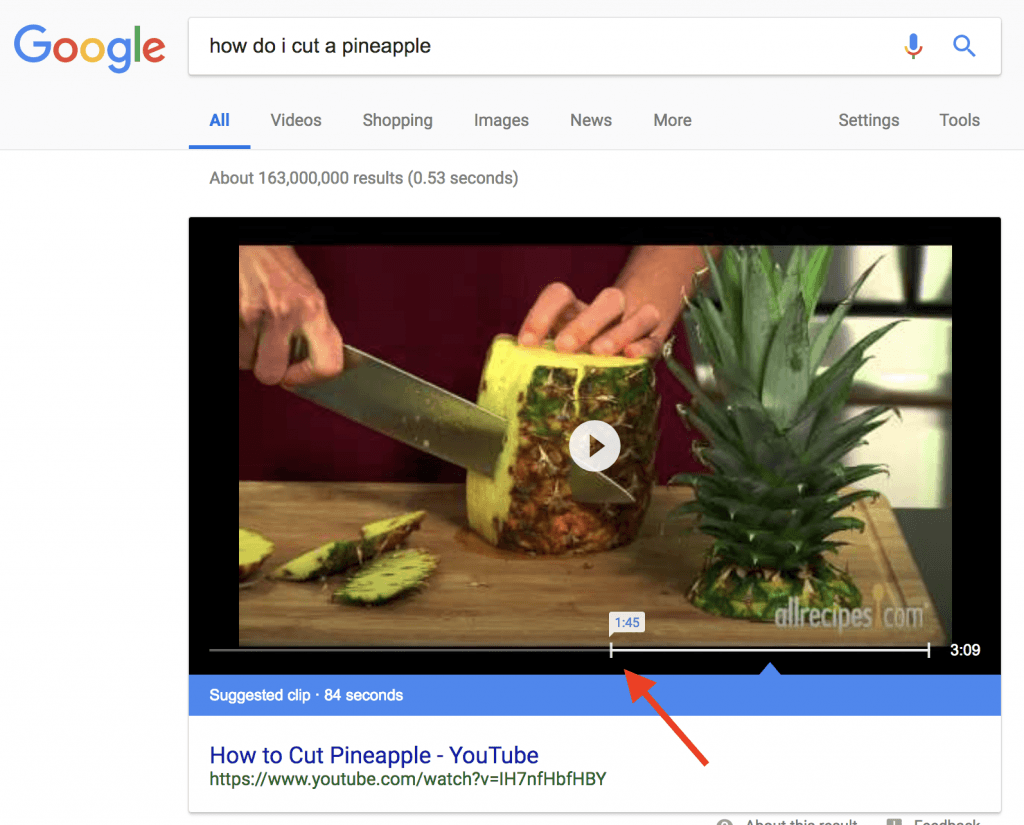
Google will sometimes show text from the video’s description box rather than the video itself in the snippet:
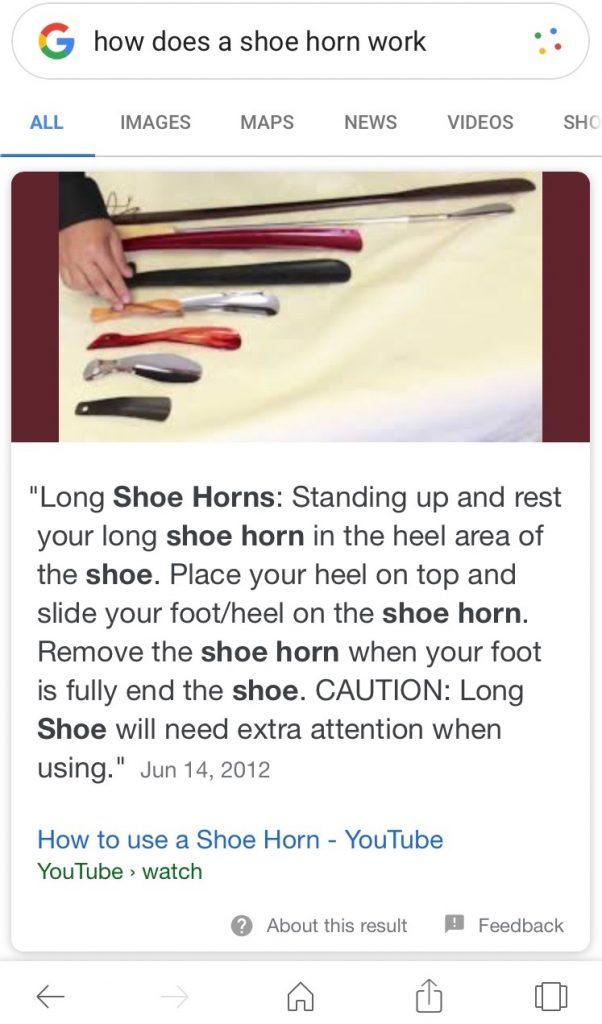
Modifying the search slightly to “how do I use a shoehorn” results in the same top result, this time with the clip rather than text:
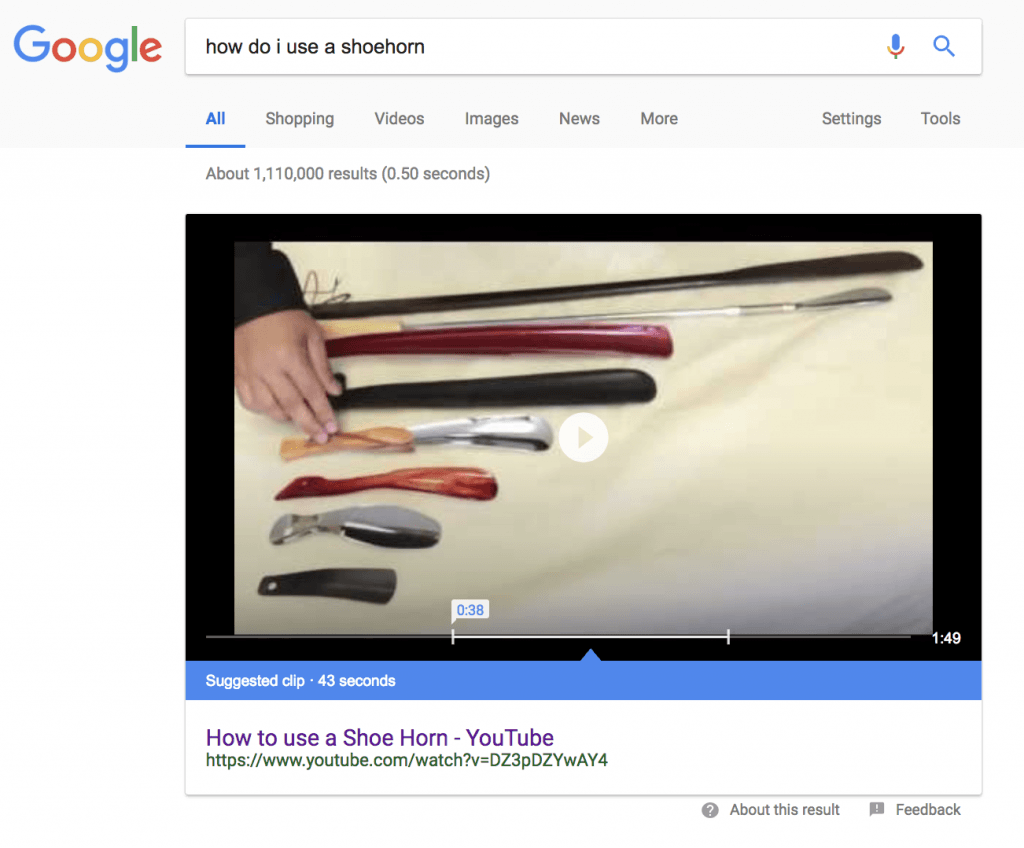
Try to rank your videos by optimizing them as part of your SEO strategy. This includes optimizing your titles and writing detailed video descriptions that use those long tail / natural language voice search keywords.
5. Make Sure Your Site Loads Fast
Google announced in July 2018 that their Speed Update was rolling out for all users.
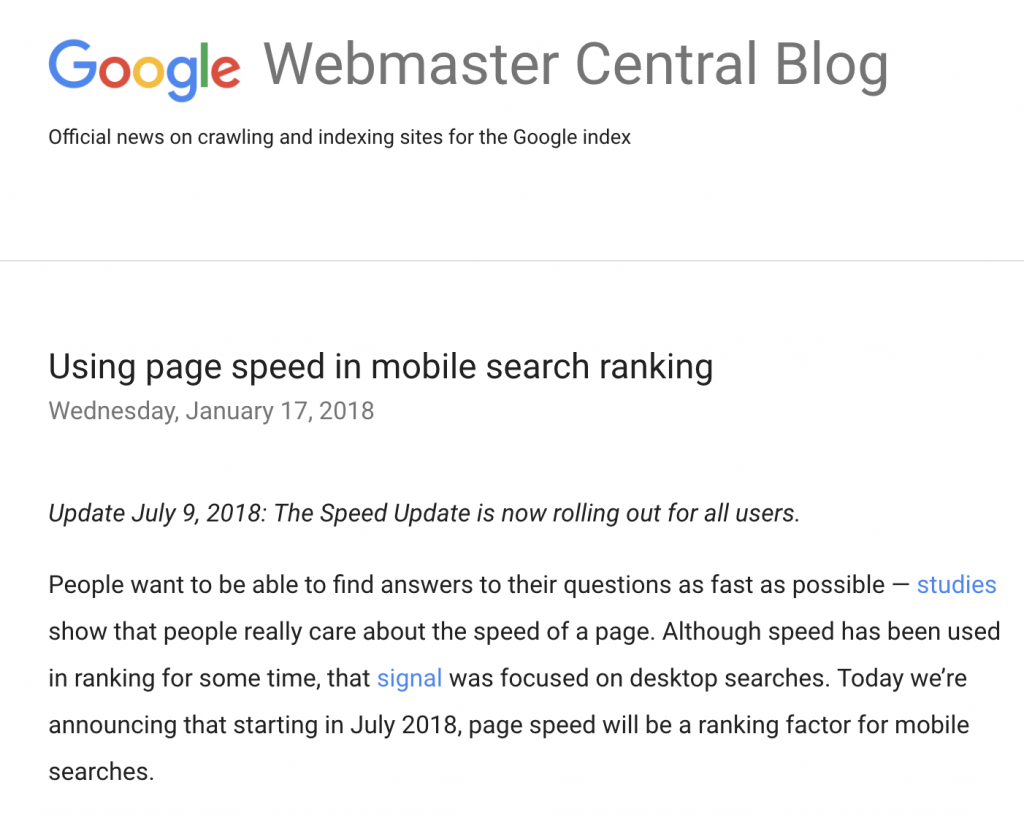
Now that page speed is a ranking factor for mobile searches, you need to consider user experience.
The average voice search result page loaded in about half the time (4.6 seconds) of the average page. Site speed is important to capture the featured snippet spot.
6. Make Sure Your Site is Mobile Friendly
Mobile-friendliness is a huge factor for ranking your site now that Google has released their Mobile First Indexing.
Since people tend to do voice searches on mobile phones more than on other devices, your chances of landing in featured snippets go way down without a mobile-friendly website.
Google has a Mobile Friendliness Test that you can use to see whether you need to optimize for mobile.

Conclusion
Now you have a foundation to optimize your website for voice search SEO.
It’s important to note that voice optimization isn’t separate from your regular SEO strategy.
Voice SEO is the new standard for best optimization practices in general, and that isn’t going to change.
If you need help building and maintaining a strategy, contact us today to find out how our SEO experts can help.

-
Want to reference this guide at a later time?
Let us send you the downloadable version so you can read it whenever.




